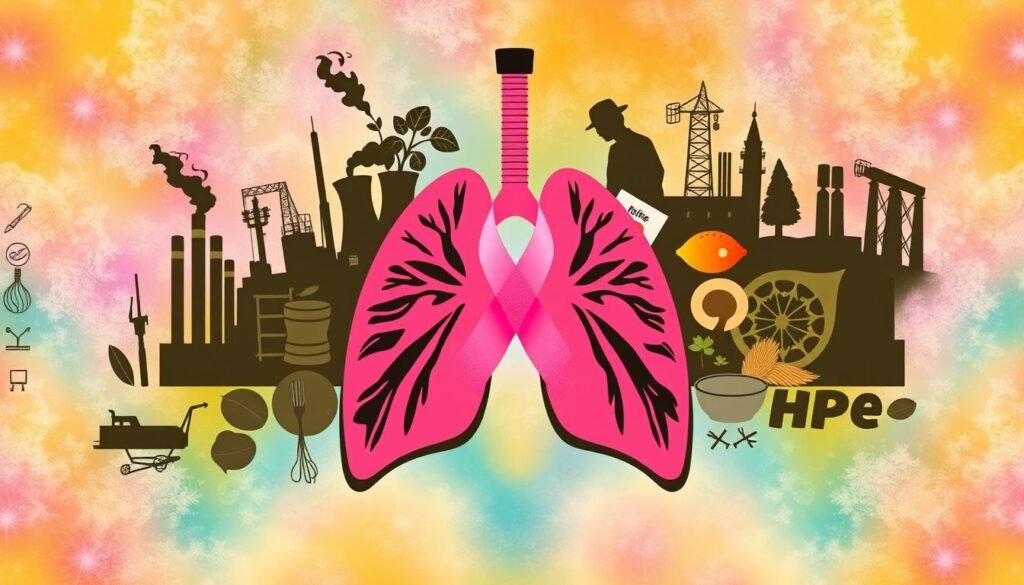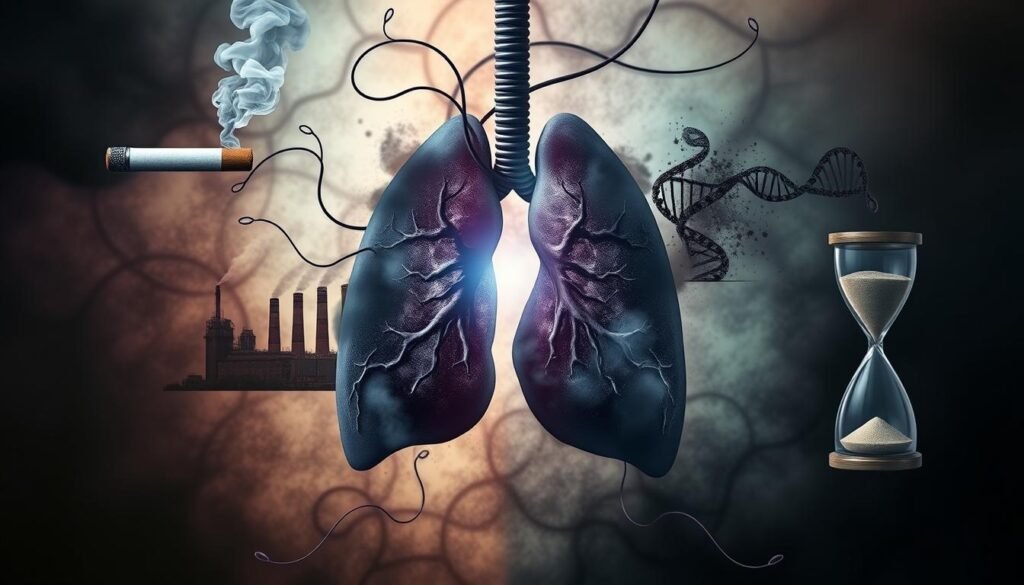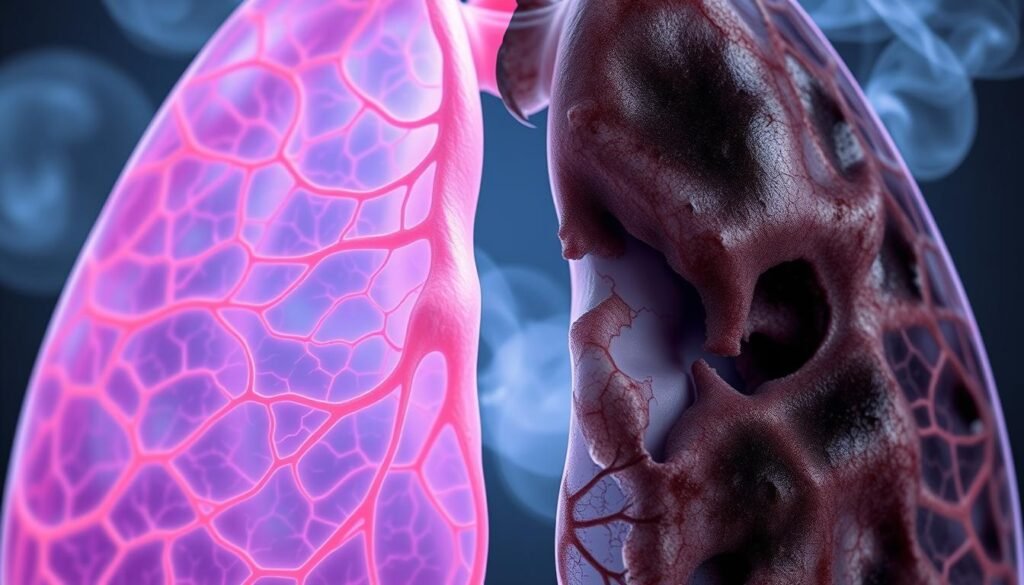Did you know that about 90% of lung cancer cases come from smoking? This shocking fact shows how tobacco use greatly affects the chance of getting small cell lung cancer (SCLC). SCLC makes up about 15% of all lung cancer types. It is known for being very aggressive and growing fast. So, it’s important to know the risk factors to prevent it or catch it early. This article will look into the different causes of SCLC, including things you can change and things you can’t.
There are many risk factors for SCLC, from work-related exposures to environmental dangers. Smoking is the biggest one, as almost every case of SCLC is in people who have smoked. But, there are other factors too, like exposure to radiation, genetics, and how we live our lives. These can all affect your chance of getting this disease. To find out more about these risk factors and how to lower your risk, check out this comprehensive guide.
Key Takeaways
- Small cell lung cancer risk factors include smoking and occupational hazards.
- Nearly all SCLC cases are linked to tobacco exposure.
- Environmental factors such as radon and asbestos significantly contribute to lung cancer risk.
- Family history may double the chances of developing SCLC.
- Preventive measures can significantly lower the risk of small cell lung cancer.
Introduction to Small Cell Lung Cancer
Small cell lung cancer (SCLC) is a fast-spreading cancer that starts in the lung tissues. It’s known as one of the aggressive lung cancer types. It mostly affects people who have smoked a lot.
This cancer is usually called small cell carcinoma or oat cell cancer. Sometimes, a rare form called combined small cell carcinoma appears. People with SCLC often have a cough, feel short of breath, have chest pain, and lose weight without trying. These symptoms highlight the importance of catching the disease early to improve treatment success.
Doctors use chest x-rays, CT scans, and biopsies to diagnose SCLC. Knowing how much the cancer has spread, or its stage, is crucial. It can be in a limited or extensive stage. Being aware of SCLC helps in spotting symptoms early and lowering cancer risk.
For more details on what increases the risk of small cell lung cancer, check out these detailed resources on lung cancer risk factors.
Understanding Risk Factors for Small Cell Lung Cancer
Knowing about the risk factors for small cell lung cancer is key if you want to avoid it. There are many factors that can lead to this aggressive cancer. They include things you can change, like smoking, and things you can’t, like your genes.
Smoking is the biggest risk. It is behind about one-third of all cancer cases and 90% of lung cancer cases. Almost 70% of smokers want to quit, but quitting is hard. Only 7% succeed. There are aids like Varenicline (Chantix) and nicotine replacement therapies to help quit and boost health.
Being around toxic chemicals at work can increase your risk. This includes exposure to asbestos and arsenic. Radon gas from soil is also a concern. Also, if you have had radiation therapy to the lungs, your risk goes up.

Research shows that genetics might also increase your risk. Some risk factors, like your habits, can be changed. But others, like family history, are out of your control. Those with a family history of lung cancer should be extra careful and consider early screening. For more details, check out this resource.
| Risk Factor | Category | Description |
|---|---|---|
| Smoking | Modifiable | Accounts for 90% of lung cancer cases, leading cause of SCLC. |
| Secondhand Smoke | Modifiable | Exposure can increase an individual’s lung cancer risk. |
| Radiation Exposure | Modifiable | Increased risk for individuals who have undergone radiation therapy. |
| Environmental Carcinogens | Modifiable | Including asbestos and arsenic in occupational settings. |
| Genetic Factors | Non-modifiable | Inherited mutations may affect lung cancer development. |
Major Risk Factors You Can Change
Knowing the big risks for small cell lung cancer helps people make smart health choices. It’s important to know that we can change some things that raise our cancer risk. Focusing on stopping smoking, avoiding secondhand smoke, and checking radon levels can make a big difference.
Tobacco Smoke and Its Impact
Smoking is the top cause of lung cancer, leading to 80% to 90% of cases in the U.S. Being exposed to tobacco smoke greatly increases the risk, making smokers 15 to 30 times more likely to get lung cancer than non-smokers. Even those who smoke less face a high danger. But quitting smoking can cut your risk by 30% to 60% within ten years.
Secondhand Smoke Exposure
Being around someone else’s smoke is also a big risk, especially for secondhand smoke lung cancer. It’s the third main cause of lung cancer in the U.S., even for people who have never smoked. Living with smokers, or in places where smoking is common, increases the risk. This shows how crucial smoke-free spaces are.
Radon Exposure and Lung Cancer Risk
Radon, a risky gas that can’t be seen or smelled, gets trapped in houses, raising cancer risk. It’s the second-largest cause of lung cancer. For non-smokers, about 26% of lung cancer deaths are linked to radon. Testing your home and fixing radon problems can greatly reduce this risk.
| Risk Factor | Impact on Lung Cancer | Modifiable? |
|---|---|---|
| Tobacco Smoke | Responsible for 90% of lung cancer cases | Yes |
| Secondhand Smoke | Third-leading cause of lung cancer in non-smokers | Yes |
| Radon Exposure | Second-leading cause of lung cancer; linked to homes | Yes |
Environmental Risk Factors
It’s key to understand environmental risks for lung cancer, especially small cell lung cancer. Harmful substances at work and in our surroundings increase these risks. Knowing about these can help prevent health issues.
Asbestos Exposure and Occupational Hazards
Asbestos is a big worry in jobs that might cause lung cancer. People working around asbestos face a high risk of getting lung cancer, especially smokers. Asbestos and smoking together are very dangerous. Every year, asbestos-related lung cancer kills about 6,000 people in the US. It’s vital for workers and bosses in construction and shipbuilding to know about asbestos dangers. For detailed info on asbestos and lung cancer, check this resource.
Other Carcinogens in the Workplace
Many harmful substances at work can lead to lung cancer. Diesel fumes, arsenic, cadmium, and chromium are among them. Pollution from power plants and burning wood also poses risks. Having safety measures at work can protect employees. These efforts can make workplaces healthier and lower lung cancer rates. Below, a table shows common workplace dangers and their health effects:
| Carcinogen | Sources | Health Risks |
|---|---|---|
| Asbestos | Construction, shipbuilding | Lung cancer, mesothelioma |
| Diesel Exhaust | Transportation, heavy machinery | Lung cancer |
| Arsenic | Pesticides, mining | Skin, lung, bladder cancers |
| Cadmium | Batteries, metal coatings | Prostate, lung cancer |
| Chromium | Alloy production, welding | Lung cancer, respiratory damage |
Risk Factors for Small Cell Lung Cancer
Knowing what increases the risk of small cell lung cancer is key to prevention. This involves understanding medical, environmental, and hereditary factors. Let’s explore the main contributors to this disease.
Previous Radiation Therapy to the Lungs
People treated with radiation therapy for lung cancer have a higher chance of getting lung cancer later on. This is especially true if the radiation targeted areas close to the lungs. The damage from radiation can make lung tissue more likely to turn cancerous.
Air Pollution and Its Effects on Lung Health
Cities with a lot of pollution see slightly more lung cancer cases. Research connects air pollution to lung health issues. Things like particulate matter and diesel exhaust are big contributors. This is vital for public health and cancer prevention talks.
Family History and Genetic Factors
Having relatives with lung cancer raises your own risk. This points to the role of genetic factors in lung cancer. Studies show certain genetic markers can increase risk by 30% to 80%. It highlights how genes and environment work together in cancer risk.

Potentially Uncertain Risk Factors
Research in lung cancer is ongoing, and some risk factors are still not clear. Knowing these risks better could help prevent and treat the disease.
Marijuana Smoking and Lung Health
Marijuana smoke contains tar and chemicals, like tobacco smoke. This makes people worry about the risk of lung cancer from smoking it. Studies have shown potential risks, including lung irritation, but we don’t fully understand the long-term effects yet.
The Role of E-cigarettes in Lung Cancer Development
E-cigarettes are a popular alternative to smoking, but they have health risks that are not yet fully known. The current knowledge shows possible risks of lung cancer, but no clear link has been found. More research is needed to see how e-cigarettes might affect lung cancer risk.

The Importance of Lifestyle Choices
The link between how we live and lung cancer risk is getting more attention. What we eat, the toxins we’re exposed to, and the vitamins we take can all play big roles. They affect our health and can change our chances of getting lung cancer.
Dietary Supplements and Lung Cancer Risk
It’s important to be cautious with vitamins. Some studies show that certain vitamins might not lower cancer risk. In fact, they could make it worse for people who smoke. Supplements like beta-carotene have been linked to more lung cancer in smokers. Knowing how vitamins affect lung cancer risk helps us make better choices.
Arsenic Contamination in Drinking Water
Drinking water with arsenic for a long time can increase lung cancer risk. This problem is more common in some parts of the world. There, arsenic levels in water are dangerously high. Even though the US has safer water, we still need to know about arsenic risks. This knowledge helps communities stay healthy and safe.
| Factor | Impact on Lung Cancer Risk |
|---|---|
| Dietary Supplements | Some may exacerbate risk (e.g., beta-carotene for smokers) |
| Arsenic Contamination | Long-term exposure correlates with increased risk |
| Overall Lifestyle Choices | Influences general health and potential cancer outcomes |
Preventive Measures and Recommendations
Preventing small cell lung cancer is crucial. By making certain lifestyle changes lung cancer, individuals can reduce their risk. Quitting smoking is the most impactful step. It cuts the chance of getting lung cancer significantly. This is because smoking is linked to almost 90% of lung cancer cases.
It’s vital to lessen radon exposure. Radon is the second main cause of lung cancer in the U.S. and can be reduced with tests and fixes at home. Testing for radon levels often, especially in high-radon areas, is a smart move.
Avoiding harmful substances at work is key for recommendations lung cancer prevention. Workers should protect themselves from asbestos and other toxins found in some jobs. This is a crucial part of preventing lung cancer.
Eating plenty of fruits and vegetables is beneficial too. Upping your intake by 100 grams each day could notably decrease lung cancer risk. This dietary approach boosts overall health, even though it’s not a sole solution.
Keeping a healthy weight is another strategy. Aim for a BMI of less than 25. Mixing regular exercise with good nutrition strengthens the body and enhances well-being.
Lastly, annual scans can save lives, especially for those at high risk. Heavy smokers and those who’ve quit in the last 15 years should get low-dose CT scans. This early detection step can drastically increase survival chances.
Research and Future Directions
Research in small cell lung cancer (SCLC) is moving fast. It is shedding light on this aggressive type of cancer. With almost all SCLC cases linked to heavy smoking, it’s key to understand how the disease works. Scientists are now focusing on the cancer’s genes and molecules to find new ways to treat it.
New studies show promise for early-stage SCLC, which is rare. These cases are doing better if treated with several approaches, including surgery. It shows how vital it is to correctly identify the cancer stage to improve survival chances. The future of lung cancer treatment could focus on each patient’s unique genetic makeup.
So far, treatments that help the immune system have had limited success. But they underline the importance of finding new treatments through research. There’s excitement about new drugs, like ones that target specific cancer cells. As these treatments get approved, patients could have much better outcomes.
Conclusion
It’s vital to understand small cell lung cancer (SCLC) to improve awareness and outcomes. About one-sixth of all lung cancers are SCLC, mainly caused by smoking. The decline of SCLC in areas with less smoking shows how effective tobacco control can be. This summary stresses the need for ongoing efforts to raise awareness about SCLC and the risks of lung cancer.
Preventative actions, making healthier life choices, and early detection are key to increasing survival rates in patients. This is especially true for older patients with stage I SCLC, where surgery could be highly beneficial. As science progresses, we aim to find more about genetic factors and markers. These could help spot SCLC early and improve treatment options.
Educating people on small cell lung cancer risks is crucial for reducing its occurrence. When individuals know their risks, they are more likely to take steps to prevent the disease. This will, in turn, lead to better health and higher survival rates among those impacted by SCLC.